Discover top guides, trends, tips and expertise from AIO Writers
Best Follow Up Email Templates: Following Up Your Lead
Julia McCoy
Friday, 28th Jul 2023
The follow-up email is one of the most important components of the sales process.
You rarely close a sale upon first contact, but according to WoodPecker research, just one follow-up email can increase your reply rate from 9% to 13%! The first follow-up email is often the most effective — with a 40% higher reply rate than the original email.
Plus, did you know that 80% of sales require five follow-ups to close the deal? Unfortunately, 44% of sales reps already give up after just sending one follow-up email and 22% give up after two emails that get no response.
This means two things: 1) salespeople need to be more persistent in following up, or 2) they are not using the best follow-up email templates that get results.
After all, the best follow-up email templates can make a world of difference. It’s important to take the time to craft a good follow-up email that nudges your lead into action without sounding annoying.
A well-written follow-up email template should be polite, concise, and informative. But how do you go about creating one?
In this blog post, you will find:
- The reasons why sales follow-up email templates are important.
- What constitutes a good follow-up email.
- Tips on how to write engaging subject lines.
- Examples of the best follow up email templates.
Ready to close more deals? Learn how to send follow-up emails now.
Table Of Contents:
- What is a Follow-Up Email?
- How to Write Follow-Up Emails
- Best Practices for Crafting Effective Sales Follow-Up Emails
- Examples of Well-Crafted Sales Follow-up Emails
- FAQs – Follow Up Email Templates
- Get Your Message Heard With The Best Follow Up Email Templates
What is a Follow-Up Email?
A follow-up email is an email or series of emails that you send to your prospect after the first email where you introduced your brand or product. Salespeople send follow-up emails that are tailored to each stage of the buyer journey.
For example:
- You can send follow-up emails while your prospect is in the middle of a free trial period to ask what they feel about the product.
- You can also send sales follow-up emails after a particular event to remind your visitors about your product or service and encourage them to take action.
Here’s a sample follow-up email from Canva:

Why Should You Send a Follow-Up Email?
Sending follow-up emails helps ensure that conversations don’t fall through the cracks. It also gives you another opportunity to get your message across.
After the initial email, sending a gentle reminder shows that you care enough to stay connected and build a relationship with your prospect.
Well-constructed follow-up emails can be extremely useful for providing additional information on products/services and nurturing leads until they are ready to buy.
Plus, when done right, they can help boost brand awareness as well as increase customer loyalty over time.
When Should You Follow Up?
Most experts recommend following up on your prospect within 24 hours of the initial email, whether through email or phone call, to keep your message fresh but avoid sounding overly eager or desperate for the sale.
You can create sales follow-up email templates for each follow-up stage so you don’t have to write one from scratch every time. All you have to do is personalize it for each specific lead.
If your prospect hasn’t responded yet but appears interested in what you have to offer, then sending out another reminder can often be beneficial as it shows that you value their opinion and are invested in hearing their input.
A follow-up email is a great way to stay in touch with contacts and build relationships. Let’s explore how to compose a courteous, professional follow-up email that will get your recipient to respond.
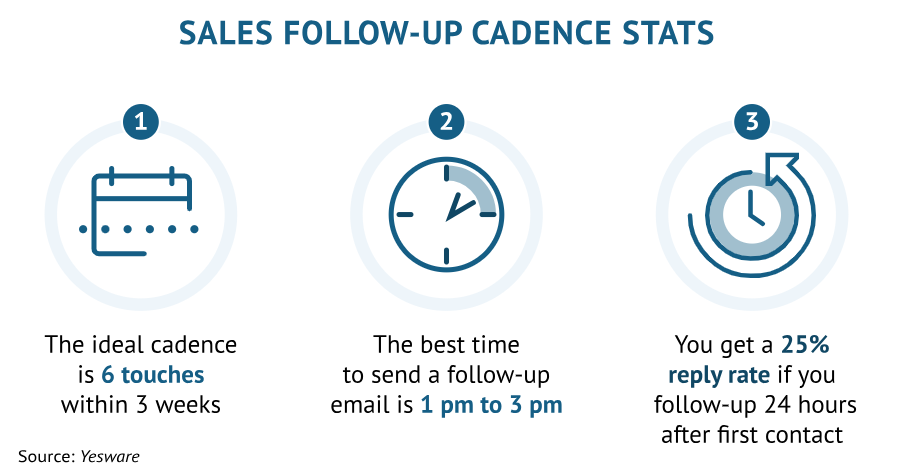



Screenshot from Fit Small Business
How to Write Follow-Up Emails
When writing follow-up emails, it’s important to highlight previous emails and interactions. Mentioning prior communications can serve as a reminder to the recipient of who you are and why they should be interested in your message.
Outline the next steps to keep the conversation moving forward. Be clear about what action needs to be taken and when, while avoiding passive-aggressive language or tone.
For better conversion rates, personalize your email subject line. Show prospects that you care enough to take the time and effort to understand their needs and preferences.
Add social proof such as customer testimonials or industry awards/accolades to add credibility to your message and increase trustworthiness. This will give them a push in the right direction when making their decision.
Writing polite follow-up emails is essential for any salesperson to increase conversions and maintain a professional relationship with their clients. By following these tips and best practices, you can increase your odds of success when sending follow-up emails.
Best Practices for Crafting Effective Sales Follow-Up Emails
When sending follow-up emails, you should know when and how to deliver them effectively:
- When reconnecting with a lead that has gone cold, remind them of previous emails or interactions you had with them. Try offering discounts or incentives to entice your prospects to get back into the conversation and make them interested in your brand again.
- Providing valuable resources such as FAQs or product information can also keep their attention focused on what you have to offer.
- When following up after meeting someone at an event, focus on relationship building by personalizing content based on post-event surveys or other forms of visitor feedback. Show that you care about their needs rather than just trying to close a sale quickly.
Subject Line
Next, let’s look at the follow-up email subject line. This is the most important part of your email! It’s the first thing your recipient sees when they open their inbox.
Did you know that 47% of email recipients open an email based on the subject line alone? And 69% chuck it immediately to the spam folder if your subject line sounds too sales-y.
Personalization
Personalization is important when writing an email subject line as it can increase open rates by up to 14%. You can personalize the subject field with your customer’s name, with your subject line written in friendly language.
Emojis
Another popular practice when writing email subject lines is inserting emojis. People love emojis! And proof of that is the 56% increase in open rates when subject lines contain an emoji.
Make sure the emoji you use makes sense with the email’s context. Beer and headphone icons might work well if you’re emailing about an event at a brewery, while the birthday and party symbols would surely look out of place in a B2B email.
Social Proof
Add social proof where possible (testimonials from other customers) to strengthen your credibility and encourage trust between both parties.
Responding to Feedback
Lastly, don’t overlook concerns or objections that were raised in previous emails. Address them right away in your follow-up strategy and allow room for negotiation while maintaining professionalism.
Now let’s look at some follow-up email samples that can take your follow-up strategy to the next level and increase conversion rates.




Screenshot from OptinMonster
Examples of Well-Crafted Sales Follow-up Emails
Sending a follow-up email can be a crucial step in the sales process. The timing of sending a follow-up email can vary depending on the context and the nature of the communication. Here are some common situations and the appropriate timing for follow-up emails, plus I’ll show you how easy it is to write emails with our AI chatbot.
1. Following Up After an Initial Meeting
After meeting with a potential client or business partner, it’s essential to promptly follow up to demonstrate that their time is valued and the conversation can progress. This shows that you value their time and are committed to moving forward.
In your follow-up email, be sure to thank them for their time, recap any important points discussed, and express your interest in continuing the conversation. This will help keep the momentum going and increase the chances of a positive outcome.
Here’s a template for a follow-up email after meetings written by BrandWell’s AIMEE chatbot:
Subject: Great Connecting Today – Next Steps
Hi [Recipient’s Name],
I hope this message finds you well. It was fantastic to meet with you today — I truly enjoyed our conversation about [specific topic discussed]. Your insights on [particular point] were particularly enlightening.
I’ve summarized the key action items we agreed upon:
- [Action Item 1]: I’ll get started on this by [date].
- [Action Item 2]: You mentioned you’d have more information for us by next week.
- [Action item 3]: We both need to touch base with our teams and circle back by [date].
Also, as promised, here are the documents we talked about:
- The project timeline.
- Our preliminary budget forecast.
- A list of potential risks and mitigation strategies.
Please take your time going through them and let me know if there’s anything that jumps out at you or needs clarification.
And just one last thing before I sign off — could we pencil in a date for our next catch-up? How does your schedule look in two weeks?
Looking forward to moving things ahead together!
Best regards,
[Your Full Name] [Your Position] [Your Contact Information]
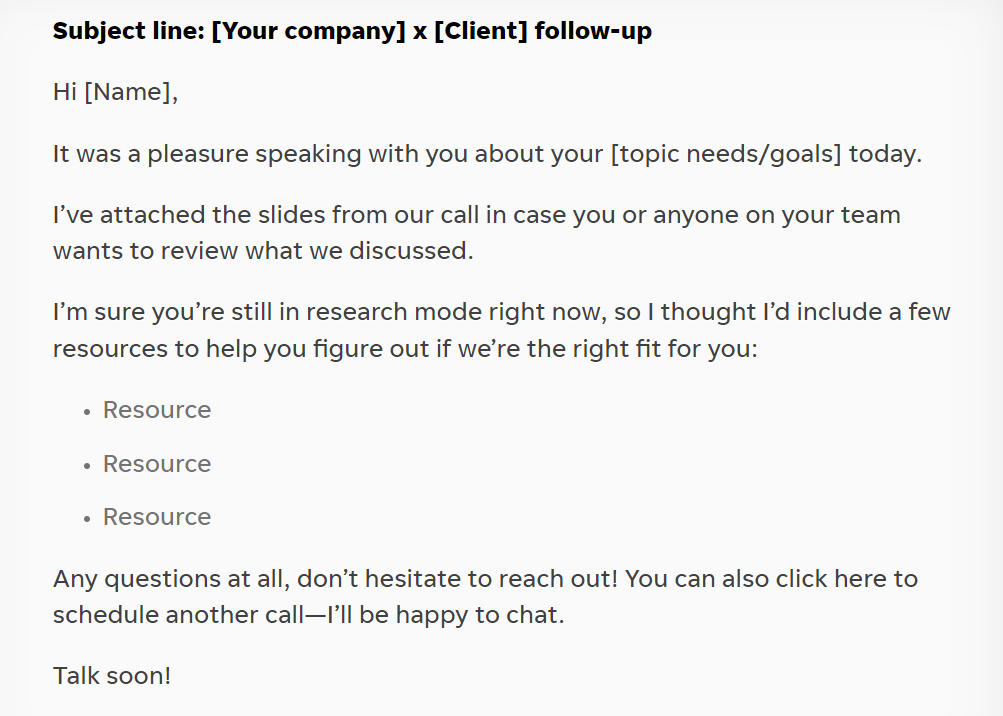





2. Following a Trigger Event
Trigger events help identify when a potential customer has taken an action that indicates they may be ready to buy. This could include opening an email, clicking on a link, or visiting your website. By recognizing these trigger events, you can quickly respond with a targeted email designed to convert them into paying customers.
For example, if someone opened an email about running shoes, then sending them another message about running shoes would make more sense than one about hiking boots even though both products are related.
In addition to providing useful information or helpful advice, it is also important that your messages contain a clear call-to-action (CTA). Make sure your CTA stands out from the rest of the text so that readers know exactly what they need to do next.
Subject: Exciting News – How We Can Help Each Other Grow
Hi [Recipient’s Name],
I trust you’re doing well! I saw the news about [trigger event, e.g., your recent product launch/new funding round/award achievement], and I wanted to reach out to congratulate you. That’s an incredible milestone for your team!
After our last conversation, I kept thinking about how our services align with your goals, especially in light of this new development. Our [specific service or product] seems like the perfect fit to help you capitalize on this momentum.
Here’s a quick reminder of how we can add value:
- Boost Efficiency: By integrating our tool, we estimate a 30% uptick in productivity.
- Expand Reach: Our platform could expose your brand to an additional 10k users monthly.
- Enhance User Experience: With features like A and B, customer satisfaction should see a notable rise.
To give you a better picture of what I mean, here are some case studies from businesses similar to yours that benefited from partnering with us.
- Case Study A
- Case Study B
Would love to chat more about this at your earliest convenience. Maybe set up a brief call next week? Your input would be invaluable as we tailor solutions specifically for your needs post-[trigger event].
Looking forward to potentially collaborating and helping each other succeed even further!
Warm regards,
[Your Full Name] [Your Position] [Your Contact Information]



3. After Meeting at a Trade Show, Networking Event, or Conference
After meeting someone at an event, it’s important to follow up with them quickly to keep their interest and build a relationship. A well-crafted follow-up email can be the difference between making or breaking that connection.
The subject line should be concise but informative so that the recipient knows what the email is about right away. It should also include something from the event such as its name or location so they know which event you’re referring to. This will help jog their memory of who you are and why they gave you their contact information in the first place.
In the body of your email, thank them for taking the time to meet with you, then provide additional information about your product or service, such as case studies. If there were any questions left unanswered during your discussion, this would also be a good opportunity to answer them in detail.
Subject: Let’s Build on Our Tradeshow Conversation
Hi [Recipient’s Name],
It was a pleasure meeting you at [Tradeshow/Event Name]. I really enjoyed our chat about [specific topic discussed] and how passionate you are about [related interest].
I’ve been thinking, and there’s a lot of synergy between our companies. Your approach to [recipient’s business area] aligns perfectly with the solutions we offer. Here’s what caught my eye:
- Shared Values: We both prioritize customer satisfaction above all.
- Complementary Services: While your team excels in X, we bring Y to the table.
- Potential for Collaboration: Together, we could tackle common challenges like Z.
To jog your memory, here is a link to our online brochure that outlines what we do in more detail: [link to online brochure]
How about continuing this conversation over coffee next week? It’d be great to explore how we can collaborate for mutual benefit. Feel free to suggest a time that suits you best.
Excited by the prospect of working together!
Warmest regards,
[Your Full Name] [Your Position] [Your Contact Information]
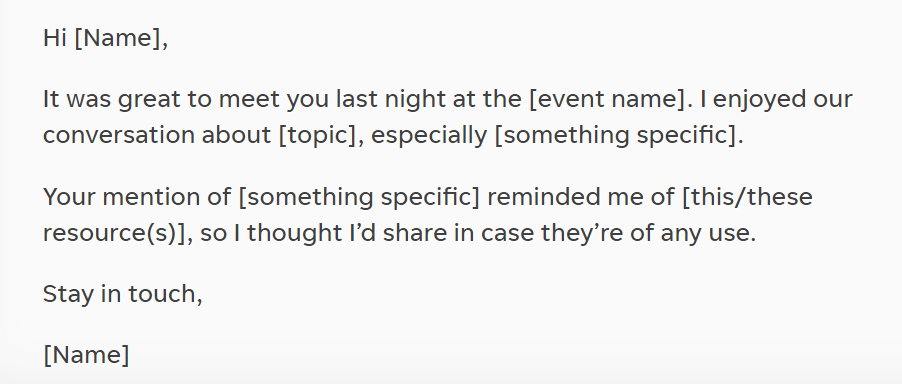





4. Immediately after Leaving a Voicemail
When you’ve left a voicemail for a lead and don’t hear back, it can be tempting to give up. But there are still ways to get their attention and ensure that your message is heard. A cold email follow-up is one of the best strategies for getting in touch with leads who have gone silent.
The key to crafting an effective cold email follow-up is making sure it’s personalized and relevant.
- Start by addressing the recipient by name and referencing your previous voicemail.
- Provide some context about why you were calling in the first place — what did you want to discuss?
- Finally, leave your phone number or email so they know how to reach you if needed.
- Alternatively, set up another call at a later date if appropriate for both parties.
Here’s an example of how to do it:
Subject: Following Up on My Voicemail – [Your Company/Product/Service]
Hi [Recipient’s Name],
I hope this email finds you well. I left you a voicemail earlier regarding our potential collaboration and how our [product/service] could really make a difference in your team at [Recipient’s Company].
In case the message got lost in translation, here’s the gist:
- Our Offering: We specialize in X that can enhance Y.
- Benefit to You: Many clients see results like Z after implementation.
- Custom Solutions: Tailored specifically to address challenges such as those you’re facing.
I’m eager to dive deeper into how we can tailor these solutions to your specific needs. To give you an idea of what we’ve achieved with others, here are some success stories: [link to case studies/testimonials]
Would it be possible to schedule a brief call or meeting next week? Your feedback would be invaluable, and I’m sure there’s much we can accomplish together.
Looking forward to hopefully hearing from you soon!
Best,
[Your Full Name] [Your Position] [Your Contact Information]






5. Offering a Free Sample, Test, or Demo
Offering prospects a free sample, test or demo can be an effective way to increase engagement. This is especially true for products or services that require some technical knowledge. By providing access to a trial version of your product or service, you allow your leads to explore its features and get familiar with how it works before committing financially.
Subject: Experience The Difference – Your Free [Product Sample/Demo] Awaits!
Hi [Recipient’s Name],
I hope all is well with you! I’m reaching out because I remember you expressing interest in our [product/service]. We believe it could really streamline your operations at [Recipient’s Company], and we’d love for you to experience it firsthand.
That’s why I’m thrilled to offer you a complimentary [sample/demo] of our latest [product/feature]. Here are some quick highlights:
- Cutting-edge Technology: State-of-the-art features that simplify tasks.
- User-Friendly Design: Crafted for ease of use, saving time and effort.
- Proven Results: Clients report seeing immediate efficiency improvements.
To get started, simply reply to this email or give me a call. We can arrange a convenient time for your free demo or discuss how to ship the sample directly to you.
Don’t miss out on this opportunity — let us show you what our solution can do!
Looking forward to your response,
[Your Full Name] [Your Position] [Your Contact Information]



Make the signing up process as simple as possible. You want potential customers to easily sign up for your offer without having any major hurdles along the way. For example, if you are providing guest logins for people who want access, then make sure they are easy to find on your website and don’t require too much effort from visitors in terms of filling out forms.
6. Making Networking and Professional Inquiries
If you’ve reached out to someone for informational interviews or business inquiries, wait at least one week before sending a follow-up if you haven’t received a response.
Subject: Checking In on [Business Inquiry/Sales Interview Request]
Hi [Recipient’s Name],
I hope this message finds you well. A little while back, I reached out regarding a [business inquiry/sales interview] for our upcoming project/initiative at [Your Company]. Since we haven’t had the chance to connect yet, I wanted to follow up and make sure my previous communication made it to your inbox.
Here’s a quick recap of what we’re looking for:
- Our Needs: Specific services or products that align with our current objectives.
- Potential Partnership: How working together could be mutually beneficial.
- Time Frame: Our ideal timeline for implementing new solutions.
Understanding how busy schedules can get, I’m more than willing to work around yours. If there’s another time or method of communication that suits you better, please let me know.
We’re really keen on exploring opportunities with your team and would appreciate any updates regarding my request.
Thank you once again for considering this — looking forward to your reply!
Best wishes,
[Your Full Name] [Your Position] [Your Contact Information]
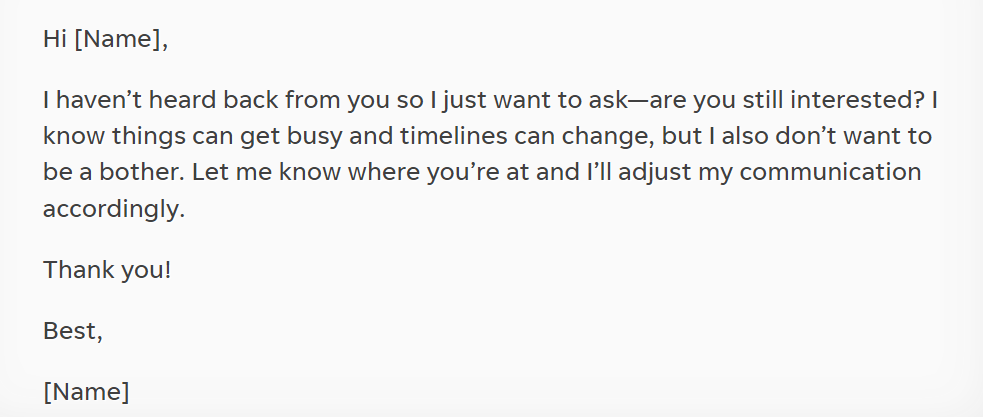





7. Sales and Business Proposals
If you’ve sent a sales pitch or a business proposal to a potential client, waiting around three to four days before sending a follow-up email can be appropriate. This time frame allows the recipient to consider your proposal without being too pushy.
Here’s a great example of how to write a follow-up email after submitting a business proposal:
Subject: Touching Base on Our Submitted Proposal
Hi [Recipient’s Name],
I trust you’re having a good day. I’m writing to follow up on the business proposal we submitted on [date of submission]. We’ve been eagerly awaiting your thoughts and any feedback you might have.
To summarize, our proposal outlines:
- Customized Solutions: Tailored specifically for [Recipient’s Company].
- Projected Outcomes: How our services/products can achieve your goals.
- Cost-Benefit Analysis: The value we offer in terms of ROI.
We understand that reviewing proposals is a thorough process and that it takes time. However, if there are any questions or further details needed from our side to facilitate the decision-making process, please don’t hesitate to reach out.
If it helps, I’d be happy to arrange a call or meeting at your convenience for us to discuss any aspects of the proposal in more detail.
Thank you once again for considering our proposition — we’re looking forward to working together and forging a strong partnership with [Recipient’s Company]/
Warm regards,
[Your Full Name] [Your Position] [Your Contact Information]
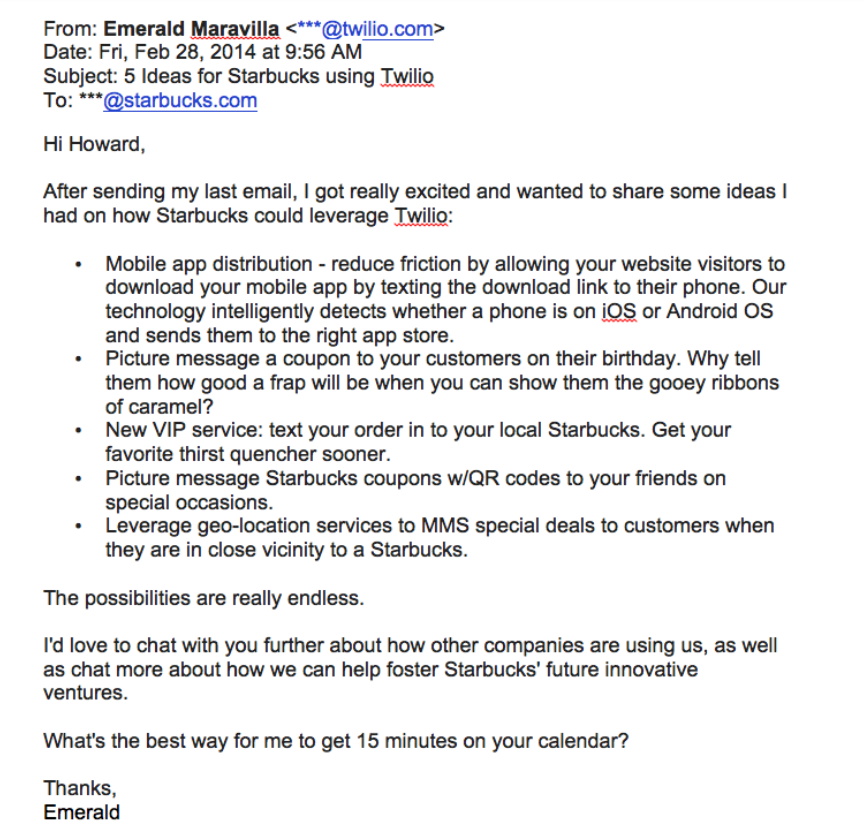





8. Meeting or Appointment Requests
If you’ve requested a meeting with someone, it’s best to follow up after about three to five days if you haven’t received a response.
Subject: Request for Appointment – Awaiting Your Availability
Hi [Recipient’s Name],
I hope this note finds you in good spirits. I wanted to touch base on the appointment request I sent through a little while ago, as we haven’t yet had the opportunity to schedule it.
We’re very keen on discussing [purpose of meeting] and believe that a face-to-face would be immensely beneficial for both parties. Here’s what we aim to cover:
- [Topic 1]: To gain insights from your expertise.
- [Topic 2]: Exploring potential areas of collaboration.
- [Topic 3]: Aligning our strategies for maximum impact.
Understanding how valuable your time is, we can accommodate whatever date and time work best for you. If there are other preferences or requirements needed before confirming an appointment, please feel free to share them with me.
Looking forward to hopefully locking in a date soon — let’s make this happen!
Best,
[Your Full Name] [Your Position] [Your Contact Information]



9. Event Invitations
For event RSVPs, it’s usually good to follow up one week before the event date to give guests a gentle reminder.
Subject: Quick Reminder: RSVP for [Event Name]
Hi [Recipient’s Name],
I hope this message finds you well! Just swinging by your inbox to gently remind you about the upcoming [Event Name] on [date]. We’re excited about the lineup and can’t wait to share it all with our esteemed guests — that includes you!
Here’s a snapshot of what we’ve planned:
- Inspiring Speakers: Industry leaders sharing their wisdom.
- Networking Opportunities: Connect with peers in a vibrant setting.
- Exclusive Previews: A first look at some of our latest offerings.
Your presence would certainly add to the event’s success. If you haven’t had a chance yet, could you please let us know if we can expect the pleasure of hosting you? An RSVP by [RSVP deadline date] would be greatly appreciated as it will help us ensure every detail is perfect.
To confirm your attendance, just hit reply or click here [link to RSVP page]. And if there are any questions or special accommodations needed, don’t hesitate to reach out.
Hope to see your name on our guest list soon!
Warm regards,
[Your Full Name] [Your Position] [Your Contact Information]



10. Following Up on the Follow-Up
It’s important to keep leads moving through the sales pipeline, but you don’t want to be too pushy or come across as desperate. The key is striking a balance between being persistent and polite.
It can be tempting to use generic email templates when sending out follow-ups in bulk, but this isn’t always the best approach. Taking the extra step of personalizing each message will show prospects that you value them as individuals rather than just another lead in your database.
Use their name at least once in your email and include specific details about how your product/service could benefit them. This helps make your message more memorable and increases its chances of success.
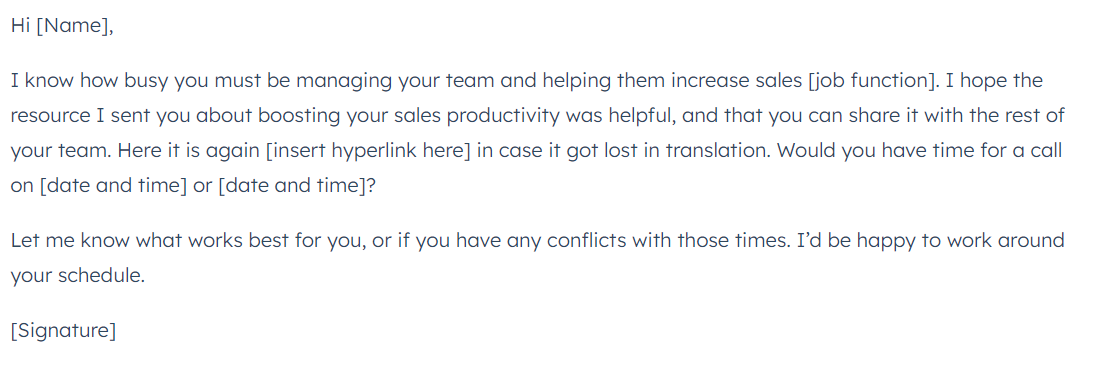


If someone hasn’t responded despite multiple attempts at contact, try adding a sense of urgency by including a deadline or limited offer within your message. For example, “This offer expires on Friday…”. This can help motivate people who may have been sitting on the fence.
Subject: Hoping to Connect – Final Attempt
Hi [Recipient’s Name],
I hope this message doesn’t intrude on your busy schedule. I’ve reached out a few times regarding [initial reason for contact], but we haven’t managed to connect yet.
I completely understand that priorities shift and time can get away from us. However, I genuinely believe in the value our conversation could bring to both of us, particularly concerning:
- Strategic Opportunities: Ways we can support each other’s business needs.
- Potential Collaboration: Discuss how our services/products align with your needs.
- Mutual Growth: Exploring avenues for partnership and shared success.
This will be my last attempt at reaching out — not because your response isn’t important, but because I respect your time and attention. If you see potential in this as well, please do respond by [specific date or timeframe] so we can take things forward.
If now is just not the right moment for such discussions — no worries at all! Feel free to reach back whenever it becomes more convenient for you.
Thank you once again for considering my messages. Wishing you continued success regardless!
Warm regards,
[Your Full Name] [Your Position] [Your Contact Information]
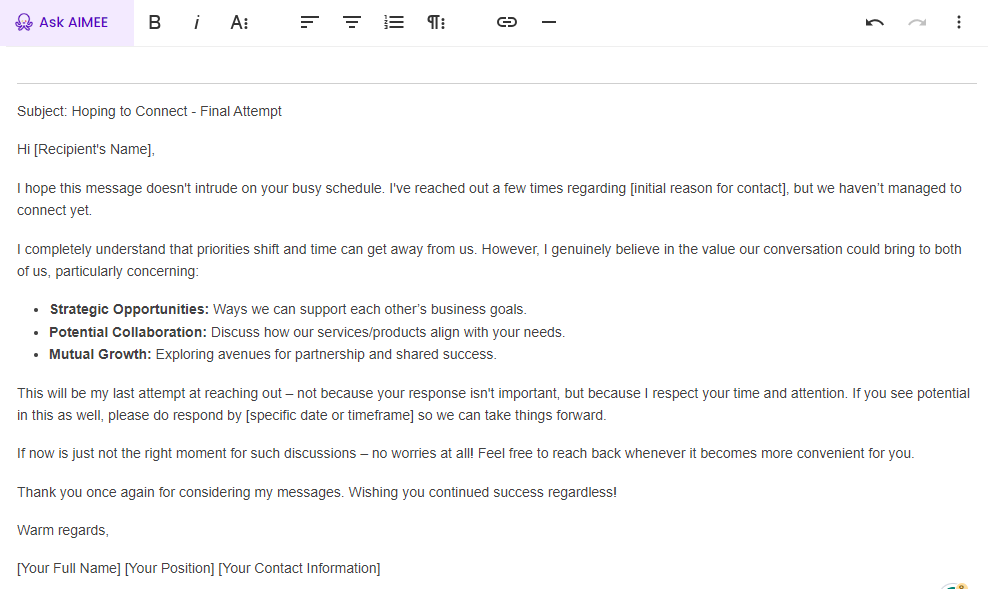

11. Mistaken Identity
No matter how disheartening it may be to realize that you have been conversing with the wrong contact, it is vital to remain friendly and not vent any frustrations so that future interactions go off without a hitch. Eventually, maintaining healthy relationships within an industry’s circle of contacts can prove invaluable in the long run.
It can be difficult to determine whether or not you’re talking to the right person. After all, sales is a numbers game and you mustn’t waste your time on someone who isn’t in a position of authority.
One of the first things you should do when trying to identify if you’re speaking with the correct person is to look at their title. Ask questions about their role and responsibilities to clarify whether or not they’re in charge of making decisions related to what you offer. It also shows them that you respect their time and aren’t just blindly pitching them without doing research beforehand.
An email template outlining why your product would be beneficial for their company is another way of determining whether or not this person has any influence over purchasing decisions within their organization. This will allow them to refer you to the right person.
12. One Last Try (Follow-Up Email Template for Your Last Pitch)
It can be frustrating when prospects don’t respond to your emails. If you’ve followed up multiple times and still haven’t heard back, it might be time to end the prospect’s journey. This will give you more time to focus on quality leads that are more likely to make a purchase.
Sometimes, the best way to get a response is by telling them you’re leaving. Adding some humor can help break down their walls and finally get an answer from them.
Here’s an email template for one final follow-up that may work.
Subject: Final Act – Our Pitch Encore
Hi [Recipient’s Name],
Just like a good espresso, I’ll keep this short and strong. We’ve pitched, you’ve pondered — now it’s curtain call time for our proposal.
If there’s room for an encore (a.k.a. another chat), I’m all ears! If not, no hard feelings; when the timing’s right, we can always revisit.
Thanks for considering us — here’s to future possibilities!
Cheers,
[Your Full Name] [Your Position] [Your Contact Information]



Remember that politeness goes a long way when it comes to follow-up emails — even if someone has ignored all previous attempts at contact. Always remain respectful throughout every interaction with potential customers – no matter how frustrated you may feel.
Got hundreds of follow-up emails to write? AI can lend a helping hand. With a chatbot like AIMEE, email stress becomes a thing of the past. It’s like having a personal assistant, making writing emails a breeze. Just enter a simple prompt and customize the AI-generated email with your details right on the text editor.
FAQs – Follow-Up Email Templates
What is a good template for a follow-up email?
A good template for a follow-up email should be clear and concise. Begin by thanking the recipient for their time, then state your purpose in the message.
Outline what action you would like them to take if applicable, or provide any additional information they may need.
Close with a polite reminder of why they must respond soon. Provide contact details so that they can conveniently reach out to you when ready.
How do you write a successful follow-up email?
It should clearly state what action you would like taken, such as a response or an update on progress. Use simple language that is easy to understand and make sure your message is polite yet assertive.
Make sure it’s relevant to the recipient and include any necessary information they need for them to act upon your request.
Finally, provide a deadline so they know when you expect a reply.
How do you write a warm follow-up email?
Writing a warm follow-up email requires careful consideration of the recipient’s needs. Begin by expressing your appreciation for their time and attention, then provide a brief overview of what you discussed or agreed upon during your last interaction.
If applicable, answer any questions they may have or provide extra materials that might be of help.
Finally, include contact information in case they need to reach out again with further inquiries.
Keep your email friendly and courteous and never use aggressive language or make demands on the reader’s time.
Get Your Message Heard With The Best Follow Up Email Templates
The best follow-up email templates allow you to stay in touch with contacts and ensure that your message is heard. By understanding the importance of writing politely, you will have greater success when sending out follow-up emails.
Remember, these are general guidelines, and it’s essential to consider the specific circumstances and the relationship with the recipient.
Be mindful not to follow up too frequently or too soon, as it may come across as pushy or annoying.
If you’re dealing with urgent matters or time-sensitive issues, adjust the timing accordingly.
Always maintain a polite and professional tone in your follow-up emails.
Follow our best examples so you feel more self-assured when creating an effective follow-up email — whether it’s your first or fifth.
Need to write follow-up emails in bulk? Let AIMEE do the talking! Sign up for BrandWell today.

UNLOCK YOUR POTENTIAL
Long Headline that highlights Value Proposition of Lead Magnet
Grab a front row seat to our video masterclasses, interviews, case studies, tutorials, and guides.



